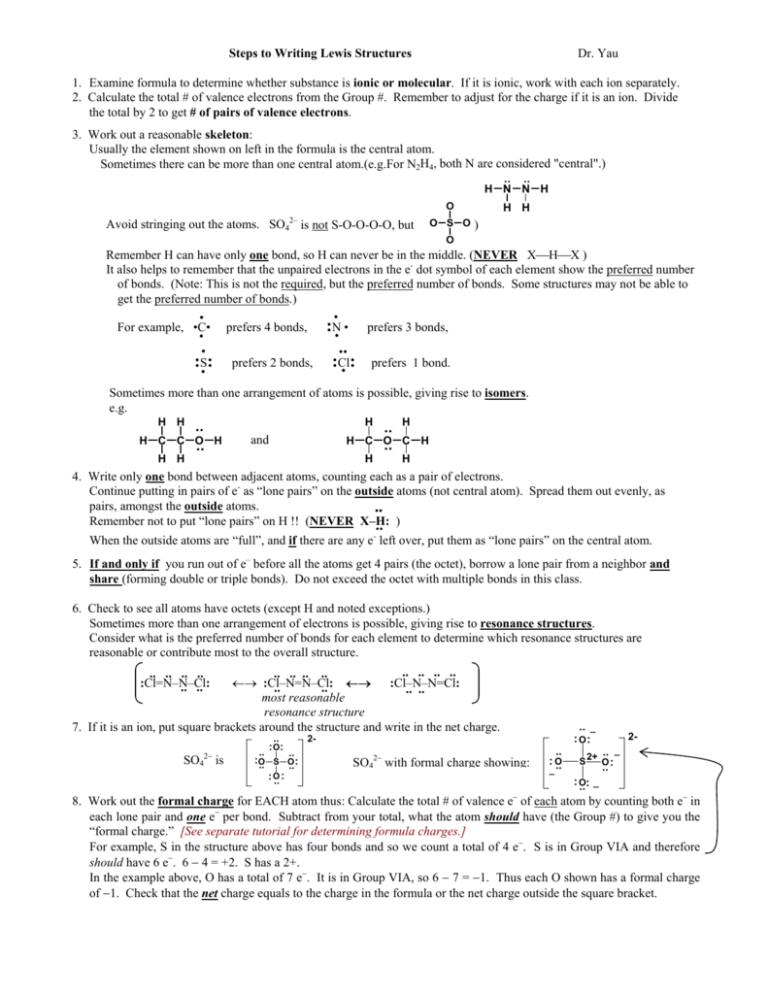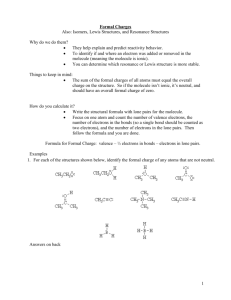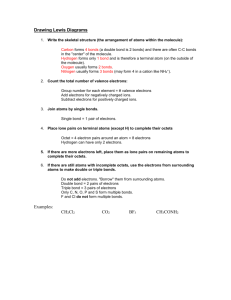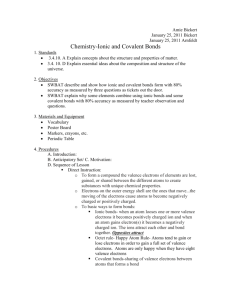How to Write Lewis Structures
advertisement

Steps to Writing Lewis Structures Dr. Yau 1. Examine formula to determine whether substance is ionic or molecular. If it is ionic, work with each ion separately. 2. Calculate the total # of valence electrons from the Group #. Remember to adjust for the charge if it is an ion. Divide the total by 2 to get # of pairs of valence electrons. 3. Work out a reasonable skeleton: Usually the element shown on left in the formula is the central atom. Sometimes there can be more than one central atom.(e.g.For N2H4, both N are considered "central".) .. .. H N N H O 2– Avoid stringing out the atoms. SO4 is not S-O-O-O-O, but O S O H H ) O Remember H can have only one bond, so H can never be in the middle. (NEVER XHX ) It also helps to remember that the unpaired electrons in the e- dot symbol of each element show the preferred number of bonds. (Note: This is not the required, but the preferred number of bonds. Some structures may not be able to get the preferred number of bonds.) • • For example, •C• prefers 4 bonds, :N• • prefers 3 bonds, • .. • :S: prefers 2 bonds, :Cl• : prefers 1 bond. • Sometimes more than one arrangement of atoms is possible, giving rise to isomers. e.g. H H H C C H H .. O .. H H and H C H .. O .. H C H H 4. Write only one bond between adjacent atoms, counting each as a pair of electrons. Continue putting in pairs of e- as “lone pairs” on the outside atoms (not central atom). Spread them out evenly, as pairs, amongst the outside atoms. .. Remember not to put “lone pairs” on H !! (NEVER X–H: .. ) When the outside atoms are “full”, and if there are any e- left over, put them as “lone pairs” on the central atom. 5. If and only if you run out of e– before all the atoms get 4 pairs (the octet), borrow a lone pair from a neighbor and share (forming double or triple bonds). Do not exceed the octet with multiple bonds in this class. 6. Check to see all atoms have octets (except H and noted exceptions.) Sometimes more than one arrangement of electrons is possible, giving rise to resonance structures. Consider what is the preferred number of bonds for each element to determine which resonance structures are reasonable or contribute most to the overall structure. .. .. .. .. .. .. .. .. ←→ :Cl–N=N–Cl: :Cl–N–N=Cl: .. .. ←→ .. .. most reasonable resonance structure 7. If it is an ion, put square brackets around the structure and write in the net charge. .. .. .. .. :Cl=N–N–Cl: .. .. .. SO42− is : .. : O .. :O S O .. .. : : :O .. 2- SO42− with formal charge showing: .. :O _ .. .. _ : O: _ 2+ .. S O: .. :O .. : _ 2- 8. Work out the formal charge for EACH atom thus: Calculate the total # of valence e− of each atom by counting both e− in each lone pair and one e− per bond. Subtract from your total, what the atom should have (the Group #) to give you the “formal charge.” [See separate tutorial for determining formula charges.] For example, S in the structure above has four bonds and so we count a total of 4 e−. S is in Group VIA and therefore should have 6 e−. 6 − 4 = +2. S has a 2+. In the example above, O has a total of 7 e−. It is in Group VIA, so 6 − 7 = −1. Thus each O shown has a formal charge of −1. Check that the net charge equals to the charge in the formula or the net charge outside the square bracket. 9. FINAL ADJUSTMENT: If the central atom has a positive formal charge, for every +1 charge, move 1 pair of lone 2pair into the adjoining bond to form a double bond. S has a +2, so you need to bring in 2 lone pairs: : O: _ _ This is considered the best way of representing SO42−. Although it has violated the Octet Rule, only two of the atoms have a formal charge. .. .. :O .. S O .. : :O : ___________________________ DEFINIATIONS YOU NEED TO KNOW: Isomers are structures with the same formula but with different arrangements of atoms. (See Step 3 above) Resonance structures are structures with same arrangements of atoms, but different arrangement of electrons. (See Step 6 above.) A resonance hybrid is the average picture of all of the reasonable resonance structures. It is a better representation of the species than any individual resonance structure. [See separate tutorial .. writing resonance hybrids.] .. on .. ... ... ... .. Cl .. N N Cl .. The following examples are organized in order of complexity. The numbering goes along with the steps described on the previous page. Example 1: Draw the Lewis structure for NH3. 1. This is molecular not ionic, so there are only covalent bonds and no ionic bonds. 2. # valence electrons = 5 (from N) + 1X3 (from H) = 8 = 4 pairs 3. Skeleton: First element listed (N) is the central atom. Surround it with the 3 H. 4. Join the atoms with ONE bond and count 1 pair for each bond. H N H H You have used up 3 pairs of valence electrons at this point, and you have 1 more pair to go. Normally you would put them as lone pairs on the outside atoms (H), but H is satisfied with only one pair of electrons and never has lone pairs, so the last pair of electrons should go onto the N. .. H N H H 5. You did not run out of electrons. The structure shown above is good, so do not put in any double bonds! 6. Double check that all atoms have octet. In this case N has an octet. H needs only one bond, so everything is good to go! 7. The original formula (NH3) does not show a charge, so it’s not an ion. However, you should check whether there are any formal charges even if there is no NET charge. (If you don’t know how to determine formal charges, there is a tutorial at my homepage on how to determine formal charges. You are supposed to always include formal charges in your Lewis structure.) N has 5 electrons and it is from Group VA, so it is neutral in this structure. H has one electron and it is from Group IA, so it is also neutral. This structure has no formal charges. Example 2: Draw the Lewis structure for PCl2−. 1. This is an ion, but it is not an ionic compound. It has only covalent bonds, no ionic bonds within the structure. 2. 5 + 7x2 + 1 = 20 = 10 pairs valence electrons (one extra electron because of the negative charge) 3. Skeleton: Cl P Cl 4. Start with putting lone pairs on the Cl and when they have the full octet, there are 2 more pairs to go, so put them on to the central atom (P). .. P .. .. : Cl .. .. : Cl .. 5. You did not run out of electrons, so you shouldn’t have double bonds! 6. All atoms have octets, so you do not need to shift electrons around. 7. The original formula show it is an ion, so you need to put square brackets and give it a charge: .. P .. .. : Cl .. .. _ : Cl .. 8. There is one more thing to do… the formal charges: P has 6 electrons and it should have 5, so it has a charge of negative one. Each Cl has 7 electrons and it should have 7, so it is neutral. The final answer to this question is… .. : Cl .. _ .. P .. .. _ : Cl .. It does not have a positive formal charge, so do not try to put in double bonds. Example 3: Draw a Lewis structure for NaOH. 1. This is an ionic compound! First separate it into the ions: Na+ and OH−. By this time you should know the formulas of the common polyatomic ions so well that you know the ions are NOT Na+, O2−, H+!! NaOH contains both ionic and covalent bonds: ionic bond between Na+ and OH−, covalent bond within the OH−. The next thing you are going to do is to work out the Lewis structure for each ion. 2. Na+ has no valence electrons (1 minus 1 equals zero). The hydroxide ion has 8 = 4 pairs of valence electrons (6 + 1 + 1 = 8). 3. Na+ is just simply Na+ because it should show no dots. OH− is the one you should be working on: Following steps 4, 5, 6, 7, 8 should bring you to the structure… .. :O .. H _ After determining the formal charges, your final answer is shown below: + Na _ .. :O .. H _ Note: There should be no solid lines connecting the Na to the OH. Solid lines represent covalent bonds and what holds Na+ and OH− together is an ionic bond (attraction between the positive and negative charges) and not a covalent bond. Example 4: Draw the Lewis structure of N2Cl2. 1. This is molecular. There are only covalent bonds. 2. 5x2 + 7x2 = 10 +14 = 24 = 12 pairs. 3. Skeleton (two N as the central atoms): Cl N N Cl 4. Remember to put lone pairs on the outside atoms (Cl) FIRST. Only when you run out of room do you put lone pairs in the central atoms (N). .. : Cl .. .. .. .. N N Cl : .. .. 5. Here we apply the rules in step 5. Read the rules CAREFULLY! It says if you don’t have enough electrons to make an octet, borrow a lone pair from the neighbor and share. “Sharing” means you bring the electrons in between the two atoms and form a second bond. In this case the N on the right is lacking one pair of electrons, so you borrow from a neighbor. There are two neighbors (N and Cl) with lone pairs from which to borrow and you need to consider both, one at a time, giving rise to 2 possible arrangements and we write double headed arrows between them. (Do not bring in the lone pairs from both N and Cl at the same time!) .. : Cl .. .. .. .. N N Cl: .. .. : Cl .. .. .. .. : N N Cl .. These are called resonance structures. There is actually another one for this molecule. In the unfinished form shown at step 4, you should have noticed that the N on the left has 2 lone pairs. One of the lone pairs could have been on the N on the right. This would lead you to two other resonance structure, but we already have the one on the right (see above). .. :Cl .. .. :Cl .. .. N N .. .. .. N N .. .. Cl: .. .. Cl: .. :Cl .. .. .. .. N N Cl: .. In other words, we have THREE resonance structures for this molecule: .. : Cl .. .. .. N N Cl : .. .. : Cl .. .. .. .. : N N Cl .. .. :Cl .. .. .. .. N N Cl: .. Finally, we are going to put in the formal charges: Final answer: + .. : Cl _ .. .. .. : N N .. Cl .. .. .. .. .. : Cl N N Cl: : Cl .. .. .. most stable resonance structure _ + .. .. .. N N Cl: .. What the formal charges tell us is the relative stability of the 3 resonance structures. The first and last resonance forms are much less stable than the one in the middle, and therefore are not expected to contribute much (if at all) to the overall structure. This is because it is much better to have no charges at all. Besides, Cl is highly “electronegative” (has a high affinity for electrons) and would not want a positive charge! This tutorial is not providing any practice questions. Perhaps in the future I will have time to put in some. Meanwhile you can practice with the questions provided in the back of the chapter that have answers in the back of the textbook. I welcome comments on this tutorial. Let me know if find any typos and anything you don’t understand! You can contact me at cyau@ccbcmd.edu





